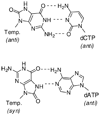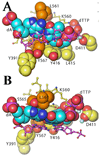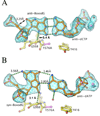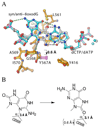Substitution of Ala for Tyr567 in RB69 DNA polymerase allows dAMP to be inserted opposite 7,8-dihydro-8-oxoguanine
- PMID: 20411947
- PMCID: PMC2882254
- DOI: 10.1021/bi100102s
Substitution of Ala for Tyr567 in RB69 DNA polymerase allows dAMP to be inserted opposite 7,8-dihydro-8-oxoguanine
Abstract
Accurate copying of the genome by DNA polymerases is challenging due in part to the continuous damage inflicted on DNA, which results from its contact with reactive oxygen species (ROS), producing lesions such as 7,8-dihydro-8-oxoguanine (8-oxoG). The deleterious effects of 8-oxoG can be attributed to its dual coding potential that leads to G --> T transversions. The wild-type (wt) pol alpha family DNA polymerase from bacteriophage RB69 (RB69pol) prefers to insert dCMP as opposed to dAMP when situated opposite 8-oxoG by >2 orders of magnitude as demonstrated using pre-steady-state kinetics (k(pol)/K(d,app)). In contrast, the Y567A mutant of RB69pol inserts both dCMP and dAMP opposite 8-oxoG rapidly and with equal efficiency. We have determined the structures of preinsertion complexes for the Y567A mutant with dATP and dCTP opposite a templating 8-oxoG in a 13/18mer primer-template (P/T) at resolutions of 2.3 and 2.1 A, respectively. Our structures show that the 8-oxoG residue is in the anti conformation when paired opposite dCTP, but it flips to a syn conformation forming a Hoogstein base pair with an incoming dATP. Although the Y567A substitution does not significantly change the volume of the pocket occupied by anti-8-oxoG, it does provide residue G568 the flexibility to move deeper into the minor groove of the P/T to accommodate, and stabilize, syn-8-oxoG. These results support the hypothesis that it is the flexibility of the nascent base pair binding pocket (NBP) in the Y567A mutant that allows efficient insertion of dAMP opposite 8-oxoG.
Figures










Similar articles
-
Using a fluorescent cytosine analogue tC(o) to probe the effect of the Y567 to Ala substitution on the preinsertion steps of dNMP incorporation by RB69 DNA polymerase.Biochemistry. 2012 Jun 5;51(22):4609-17. doi: 10.1021/bi300241m. Epub 2012 May 22. Biochemistry. 2012. PMID: 22616982 Free PMC article.
-
Substitution of Ala for Tyr567 in RB69 DNA polymerase allows dAMP and dGMP to be inserted opposite Guanidinohydantoin.Biochemistry. 2010 Oct 5;49(39):8554-63. doi: 10.1021/bi100913v. Epub 2010 Sep 9. Biochemistry. 2010. PMID: 20795733 Free PMC article.
-
How DNA polymerase X preferentially accommodates incoming dATP opposite 8-oxoguanine on the template.Biophys J. 2013 Dec 3;105(11):2559-68. doi: 10.1016/j.bpj.2013.10.014. Biophys J. 2013. PMID: 24314086 Free PMC article.
-
RB69 DNA polymerase structure, kinetics, and fidelity.Biochemistry. 2014 May 6;53(17):2752-67. doi: 10.1021/bi4014215. Epub 2014 Apr 23. Biochemistry. 2014. PMID: 24720884 Free PMC article. Review.
-
DNA polymerase structure-based insight on the mutagenic properties of 8-oxoguanine.Mutat Res. 2010 Nov 28;703(1):18-23. doi: 10.1016/j.mrgentox.2010.07.013. Epub 2010 Aug 7. Mutat Res. 2010. PMID: 20696268 Free PMC article. Review.
Cited by
-
Binary complex crystal structure of DNA polymerase β reveals multiple conformations of the templating 8-oxoguanine lesion.Proc Natl Acad Sci U S A. 2012 Jan 3;109(1):113-8. doi: 10.1073/pnas.1112235108. Epub 2011 Dec 16. Proc Natl Acad Sci U S A. 2012. PMID: 22178760 Free PMC article.
-
DNA polymerases provide a canon of strategies for translesion synthesis past oxidatively generated lesions.Curr Opin Struct Biol. 2011 Jun;21(3):358-69. doi: 10.1016/j.sbi.2011.03.008. Epub 2011 Apr 7. Curr Opin Struct Biol. 2011. PMID: 21482102 Free PMC article. Review.
-
The miscoding potential of 5-hydroxycytosine arises due to template instability in the replicative polymerase active site.Biochemistry. 2011 Nov 29;50(47):10350-8. doi: 10.1021/bi201219s. Epub 2011 Nov 3. Biochemistry. 2011. PMID: 22026756 Free PMC article.
-
Transcription-Coupled Template Reconfiguration of 8-Oxoguanine for Error-Prone Transcription Revealed by Time-Resolved X-ray Crystallography and Molecular Dynamics.J Am Chem Soc. 2025 May 14;147(19):16396-16403. doi: 10.1021/jacs.5c02687. Epub 2025 Apr 30. J Am Chem Soc. 2025. PMID: 40305462 Free PMC article.
-
Using a fluorescent cytosine analogue tC(o) to probe the effect of the Y567 to Ala substitution on the preinsertion steps of dNMP incorporation by RB69 DNA polymerase.Biochemistry. 2012 Jun 5;51(22):4609-17. doi: 10.1021/bi300241m. Epub 2012 May 22. Biochemistry. 2012. PMID: 22616982 Free PMC article.
References
-
- Roberts JK, Kunkel TA, editors. DNA replication in eukaryotic cells: concepts, enzymes and systems. Plainview, NY: Cold Spring Harbor Laboratory Press; 1996.
-
- Kunkel TA, Erie DA. DNA mismatch repair. Annu. Rev. Biochem. 2005;74:681–710. - PubMed
-
- Marnett LJ. Oxyradicals and DNA damage. Carcinogenesis. 2000;21:361–370. - PubMed
-
- Lindahl T. Instability and decay of the primary structure of DNA. Nature. 1993;362:709–715. - PubMed
Publication types
MeSH terms
Substances
Grants and funding
LinkOut - more resources
Full Text Sources
Miscellaneous

